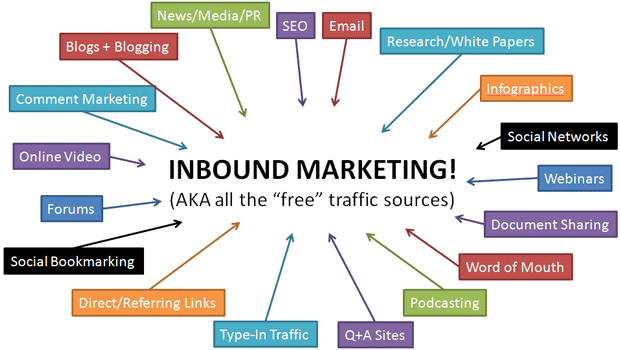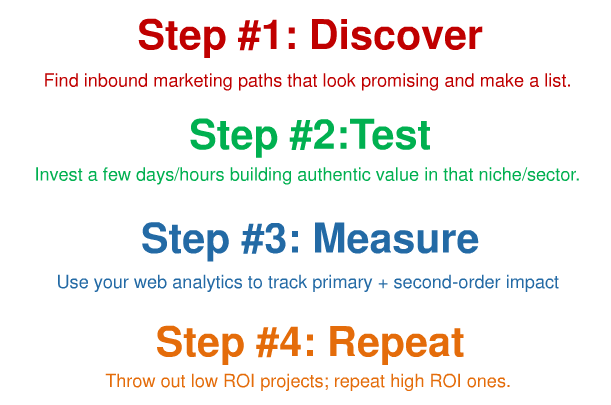
App Store SEO Not Enough: Why Mobile App Publishers Need Inbound Marketing
This YouMoz entry was submitted by one of our community members. The author’s views are entirely their own (excluding an unlikely case of hypnosis) and may not reflect the views of Moz.
The benefits of inbound marketing for SEO are clear: 90% of web traffic is driven by search engines, content creation and social media - it’s almost all organic. If you want to build a lasting web business it’s obvious you can’t ignore it. After all, you can see the difference search engines make in your own visitor logs.
Sadly, it’s a very different story for app publishers. There is a common misconception that the only way to get organic traffic is through the App Store. Hence developers worry about App Store Optimization (ASO), and not so much about web traffic. Simply put, if you're an app publisher you probably didn't think inbound marketing was for you.
Have you noticed that most apps have very rudimentary sites, with very little content? Most app publishers have a product-driven, build-it-and-they’ll-come approach. When apps do have a web presence, they’re often very basic funnels that send visitors to their App Store page. They miss out on the opportunity to pre-sell the benefits of their apps and build trust before the user arrives to the actual app store page.
App developers need to start taking advantage of the web and start thinking like web publishers. Build it, market it, then users will come.
The App Store is not your marketing company, you are
Relying on the App Store for discovery is no longer a sound strategy with over 700,000 apps fighting for visibility.
Even though app store optimization tactics exist, they’re still far from the potential of what the web can offer in terms of SEO - exactly why Moz is sticking to the web. Let’s take a closer look...
Here’s what the App Store offers (the build-it-and-they’ll-come strategy):
- Title
- Icon
- Some keywords
- Description
- A few screen shots
- User reviews
Here’s what web marketing offers you:

You’ve probably seen this image before, but it serves as a great reminder that your inbound bucket list is nothing short of full. It’s time to make your own luck and create a website that’s worth visiting: build-out a blog, create content, develop a social media presence, and show visitors that you’re worth interacting with. Familiarity and information build trust.
The problem with inbound marketing for apps
As a mobile publisher or digital agency you may be thinking:
‘Alright, so you’re telling me to spend time using inbound marketing to drive app downloads - blogging, content, social media, email etc. - but how do I know where to direct my efforts? I can’t tell what’s working!’
Ok, so maybe I should cut everyone a little slack. The problem begins with the fact that a lot of these channels are difficult to measure. For mobile app publishers, this difficulty is compounded by the fact that, so far, services like Google Analytics had no way to measure conversions - i.e. successful app downloads driven by traffic originating somewhere on the web. The App Store only tells you, in aggregate, how many people have downloaded your app, shedding no light on where those users actually came from - completely denying you access to any web referrer data for your app activations. But the landscape is changing, and within challenge lies great opportunity.
Access to the right data is evolving and opening up very quickly, allowing mobile publishers and app marketers to finally track key metrics for their campaigns. A team of Canadian app makers, who I work for, felt this great need and created Tapstream, enabling the ability to relate downloads to the original inbound channels that drove them. You can correlate referring URLs, search engine keywords and even landing pages to app activation numbers, helping you fine-tune your web strategy. A new world of measurement has just opened.
For the first time, app publishers have the ability to calculate both the cost of customer acquisition (CoCA) and customer lifetime value (LTV) for a given inbound channel. So, what does this mean? As an app marketer, you can finally measure the ROI of your SEO efforts and get smarter. How much does it cost to acquire a new app user via blogging, content creation, and social media, vs. paid channels like Google AdWords? Which of these channels brings in the most valuable customers? Now you can find the answers.
Calculating effectiveness and profitability of app marketing: CoCA and LTV
CoCA is a great measure of how your marketing is doing. The lower the cost of acquiring a customer the better - as long as your marketing is bringing in the right customers. That’s where LTV comes in. Once you rope in some customers, you need to ensure you keep them happy so they stick around (a low churn rate) and you can monetize them - maximizing their worth to you throughout your relationship by offering a valuable product or service.
CoCA is calculated by taking your cost of sales and marketing for a given period and dividing it by the # customers you acquire during that period.
For example:
Say you spend $1,500 to sponsor a blog, and get an ad placement for one week. You use a unique tracking URL on your ad, and at the end of that week your analytics service tells you that your ad as driven 10 new sign-ups. Your CoCA, or cost to acquire a customer in this case is $150. Paid channels tend to be more straightforward to compute, nonetheless the same process is used for inbound channels (see final example below).
The goal here is to test different marketing channels through both paid and inbound campaigns in order to discover which channels are the most effective for bringing in new customers. Keep in mind, your ability to sell, using landing pages and persuasive sales copy, plays a large role in how well your campaigns perform.
Now that you’re acquiring customers, It’s time to make sure they’re worth it. At the end of the day, you don’t want to sign up people who don’t really want your service.
LTV is the Gross Margin you expect to make from a customer during your entire relationship. LTV takes some time to understand as you’ll have to experiment with pricing and get a sense of how long your customers stick with you, but it will provide invaluable information on how effective both your marketing and product are.
For example:
A customer signs up for your service on a subscription plan of $100/month, and they stay with you for two years giving you a LTV of $2,400.
The trick here is to track where each customer comes from so you can figure out which marketing channels - your emails, social campaigns, videos, ads, contests etc. - are driving customers with the highest LTV. And once you have a baseline understanding of your LTV, you can adjust your pricing and marketing strategy to increase it.
Final example - CoCA and LTV together for an inbound channel:
During Eric Siu’s interview with Leo Widrich from Buffer, Eric asked Leo: “How do you measure your guest blogging efforts?” Leo responded:
“We do track traffic for starters of course. Normally, we said: can this post get us at least 100 visitors? If yes, that means two paying users (we have a 2 percent conversion rate) and we have a LTV of $220/user. One article takes around 1-2 hours, so we get around $450 per post. That sounded like a good calculation and has worked very well for us.”
Note: in this case, CoCA is 1-2 hours of writing for every two users (you decide what your time is worth).
Overall the goal, of course, is to keep CoCA less than LTV. You can often accelerate growth by aggressively spending on acquisition and as long as you keep the costs below your LTV value you will see positive returns. Calculating CoCA and LTV for web businesses is fairly straightforward using services like KISSmetrics, but mobile developers, marketers and agencies need to expand regular web analytics with mobile-specific solutions like Tapstream.
Once you’ve measured some results, act on the data to scale your campaigns. Keep your inbound efforts agile by following these four steps that Rand mentions in his presentation Inbound Marketing for Startups in 2011:

Remember: if you’ve (wisely) chosen inbound marketing as your SEO strategy, building trust takes time, so you're in it for the long haul. Make a habit of refining your campaigns, and it will pay dividends down the road.
Conclusion
The days of having your mobile app discovered organically with a simple app store listing are long gone. App publishers need to start making their own luck and inbound marketing is something they can plan, execute and grow at their own pace.
Taking the structured four-step approach above will help you track your results and create a useful feedback loop to discover what’s working, and just as importantly, what’s not. Double-down on your successes to keep both your budget and customer acquisition healthy.
SEOmoz wasn’t built in a day, nor was Angry Birds. Build, measure, learn, and start building your own web fan base.
Your Turn
What inbound marketing channels have worked well for your app?
How are you measuring them?
Let me know in the comments below, and thanks for reading!
About the author: Robin Campbell is a web marketer, dancer and adventure junkie, currently helping app publishers market smarter on the web with Tapstream analytics. Have app marketing questions? Tweet him at @tapstreamapp.




Comments
Please keep your comments TAGFEE by following the community etiquette
Comments are closed. Got a burning question? Head to our Q&A section to start a new conversation.